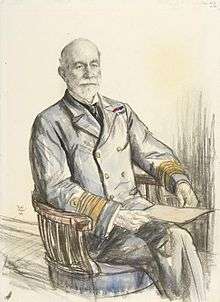Frederick Hamilton (Royal Navy officer)
Admiral Sir Frederick Tower Hamilton GCVO, KCB (8 March 1856 – 4 October 1917) was a senior Royal Navy officer who went on to be Second Sea Lord and Chief of Naval Personnel.
Sir Frederick Hamilton | |
|---|---|
 1917 portrait by Francis Dodd | |
| Born | 8 March 1856 London, England |
| Died | 4 October 1917 (aged 61) Rosyth, Scotland |
| Allegiance | |
| Service/ | |
| Years of service | 1869–1917 |
| Rank | Admiral |
| Commands held | HMS Rattlesnake[1] HMS Bulwark[2] Commander-in-Chief, Rosyth |
| Battles/wars | Zulu War First World War |
| Awards | Knight Grand Cross of the Royal Victorian Order Knight Commander of the Order of the Bath |
Naval career
Hamilton joined the Royal Navy in 1869[3] as a cadet on the training ship Britannia.[1] He fought in Naval Brigade in the Zulu War in 1879, for which service he was mentioned in despatches.[3] After promotion to Lieutenant he specialised into the Torpedo Branch and in 1884 after training was appointed a staff officer at the Torpedo Schoolship HMS Vernon.[1] In 1892 he was promoted to commander and serving aboard the battleship HMS Hood. He was appointed in command of the torpedo school ship HMS Defiance at Devonport on 1 November 1897,[4] promoted to captain on 1 January 1898,[5] and re-appointed in command of the Defiance the same day.[6] On 18 March 1902 he was appointed flag captain of the battleship HMS Bulwark, which in May was to become flagship of Admiral Sir Compton Domvile, Commander-in-Chief of the Mediterranean Fleet.[7] Hamilton was Aide-de-Camp to the King between 1906 and 1907.[8]
At the outset of the First World War Hamilton was Second Sea Lord and Chief of Naval Personnel and was promoted to full admiral in June 1916.[9] He went on to be Commander-in-Chief, Rosyth later that year[10] but died suddenly from a heart attack in 1917 and is buried in Fife.[11]
He lived at Anmer Hall near King's Lynn in Norfolk.[8]
Honours and awards
- 21 November 1903 – During the visit of the King to Malta Captain Frederick Tower Hamilton, Royal Navy, Flag Captain to Commander-in-Chief, Malta was appointed a Member of the Royal Victorian Order.[12]
- 9 November 1908 – Rear-Admiral Frederick Tower Hamilton, MVO, is promoted to be a Commander of the Royal Victorian Order[13]
- 1 January 1913 – Vice-Admiral Frederick Tower Hamilton, CVO, is appointed a Knight Commander of the Order of the Bath[14]
Family
Hamilton married Maria Walpole Keppel, the daughter of Admiral Sir Henry Keppel; they went on to have two sons (including Admiral Sir Louis Keppel Hamilton) and two daughters.[8]
References
- "Death of Admiral Sir F.T. Hamilton". Deaths. The Times (41601). London. 5 October 1917. col D, p. 11.
- The Dreadnought Project
- "National Maritime Museum". Archived from the original on 2 August 2011. Retrieved 17 July 2010.
- "Naval & Military intelligence". The Times (35338). London. 19 October 1897. p. 8.
- "No. 26924". The London Gazette. 31 December 1897. p. 7854.
- "Naval & Military intelligence". The Times (35408). London. 8 January 1898. p. 10.
- "Naval & Military intelligence". The Times (36707). London. 5 March 1902. p. 5.
- The Peerage.com
- "Admirals.org.uk". Archived from the original on 3 March 2016. Retrieved 17 July 2010.
- "Dunfermline Heritage Roots". Archived from the original on 3 July 2015. Retrieved 17 July 2010.
- "Great War Forum". Archived from the original on 29 February 2012. Retrieved 17 July 2010.
- "No. 27560". The London Gazette. 2 June 1903. p. 35235.
- "No. 28194". The London Gazette. 9 November 1908. p. 8162.
- "No. 28677". The London Gazette (Supplement). 1 January 1913. p. 1.
External links
- The Dreadnought Project: Frederick Hamilton
| Military offices | ||
|---|---|---|
| Preceded by Sir John Jellicoe |
Second Sea Lord 1914–1916 |
Succeeded by Sir Somerset Gough-Calthorpe |
| Preceded by Sir Robert Lowry |
Commander-in-Chief, Rosyth 1916–1917 |
Succeeded by Sir Cecil Burney |